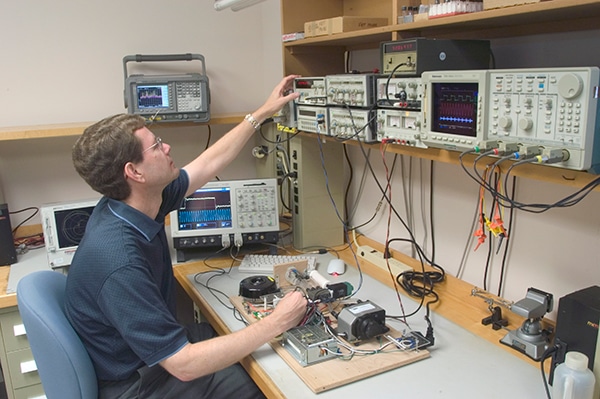Table Of Content

Take a look back with our first editor and discover some of our favorite articles. Custom Compiler facilitates design/layout collaboration that makes it easy to communicate design intent and achieve analog design closure, as shown below. Our newsletter provides updates on newly available products, solutions, published articles, webcasts and other resources that contribute to innovative design. If you’re an electrical engineering student or recent graduate with an interest in analog electronics, you’re just a click or two away from articles, tutorials, and a wealth of other helpful resources.
Understanding Simple DC Power Supply Circuits
It is far from impossible to encounter designs that operate solely in one domain. Mixed-signal technology, as it’s known, incorporates both analog and digital elements into its design, whether this is at the component or board level. Any type of transistor can be applied as an amplifier, a switch, or a voltage-controlled resistor, but some are more fitted to specific applications.
Amplifier circuits
Each circuit below is presented as a "definition-by-example" and includes step-by-step instructions with formulas enabling you to adapt the circuit to meet your design goals. If you're new to amplifier design, we highly recommend completing our TI Precision Labs (TIPL) training series. There are many options in the market (as seen in Figure 7), and often schematic/simulation tools can be interfaced with the PCB editor, allowing to simply export the NETLIST from one TO the other. For instance, PSPICE schematics can be automatically exported to Allegro. Analog design in the context of integrated circuit (IC) design is a discipline that focuses on the creation of circuits that operate in and are optimized for continuous time-domain behavior. The first laboratory develops model for three different types of ESD clamps including the rate-independent clamps LVTSCR and GGNMOS.
AXPONA Preview: Analog Audio Design TP-1000 Reel-to-Reel Tape Player - AnalogPlanet.com
AXPONA Preview: Analog Audio Design TP-1000 Reel-to-Reel Tape Player.
Posted: Wed, 03 Apr 2024 07:00:00 GMT [source]
Non-linear circuits (rectifiers/clamps/peak detectors)

This tool searches for violations of the design rules, as well as mismatches between the NETLIST and layout. Finally, using the 3D viewer tool, one can verify the final appearance of the PCB, and check if the component spacing is feasible. Cadence PCB solutions is a complete front to back design tool to enable fast and efficient product creation. Cadence enables users accurately shorten design cycles to hand off to manufacturing through modern, IPC-2581 industry standard. This article explains the sources of EMI – specifically radiated emissions – and presents techniques to minimize EMI for an analog signal chain, including detailed layout examples and measurement results. Once you have enrolled in a course, your application will be sent to the department for approval.
Out-of-production analog audio equipment well over half a century old can still fetch thousands of dollars, despite the fact that modern digital replacements can sometimes be a significant fraction of the cost. As it turns out, and perhaps in a case of benign Stockholm syndrome, some have taken a liking to the inherent noise of analog media - the warmth as it's denoted by some. Though it may sound bizarre to the average designer, certain distortion levels may in fact be sought out by enthusiasts. From fundamentals to deep dives, our online video tutorials help you design and develop with TI products, tools, software, and applications. Explore our library and discover training materials for everything from amplifiers to zeta converters. Check out the latest insight from our technical experts on analog circuit design techniques and emerging applications.
ADALM2000 Activity: Audio Amplifier with Electret Microphone
From Figure 11, one can see that the frequency response is similar to the one obtained by the Webench Filter Design tool, proving that changing the amplifier did not modified significantly the filter behavior. Besides AC sweep, PSPICE and other simulators provide transient simulation, BIAS point calculation, DC Sweep, noise analysis, Monte Carlo simulations, etc. In our case, the Monte Carlo simulation is important to check the envelope of the gain curve, that is, if the variations caused by component tolerances are acceptable. The Monte Carlo simulation was performed using 100 runs and a Gaussian distribution of component values, resulting in a worst-case variation smaller than 1.0 dB.
High-speed analog systems will need an alternate method of tying the ground planes, however. Ostensibly, the topic of split ground comes up when discussing mixed-signal designs. Split ground is the concept of dividing the ground between analog and digital components and traces. This has become a PCB topic that tends to attract some less than rigorous best practices for an engineering discipline. This reflexive statement may seem painfully obvious, but it’s worth highlighting that separating the grounds into two separate classes does nothing to the underlying role as a reference.
Design of analog CMOS integrated circuits
For example, let consider that we do not have access to a THP210 amplifier, but we have one AD825 (from Analog Devices™) spare in the laboratory. To verify if the AD825 is still able to achieve the filtering properties that we need, we can run a simulation in PSPICE to validate the frequency behavior of the new filter. After the analog design is complete and validated by simulations, the engineer must design the printed circuit board (PCB). Many designers tend to neglect the negative effects caused by poor routing, but this is not the most efficient approach. When developing an electronic project, one should treat the PCB as a crucial component of the circuit, that must be designed carefully to avoid practical problems. Analog design might seem somewhat outdated in the modern world of digital circuits, but it still serves a unique and irreplaceable purpose.
Multiplexer (MUX) and Demultiplexer (DEMUX) Applications
Before enrolling in your first graduate course, you must complete an online application. Please click the button below to receive an email when the course becomes available again. All rights are reserved, including those for text and data mining, AI training, and similar technologies.
This issue features topics from the impacts of ADC noise to comparing dual-supply discrete and integrated instrumentation amplifies. This issue features topics on designing with ADCs along with optimizing battery life in your application. Synopsys is a leading provider of high-quality, silicon-proven semiconductor IP solutions for SoC designs. Both individuals and organizations that work with arXivLabs have embraced and accepted our values of openness, community, excellence, and user data privacy. ArXiv is committed to these values and only works with partners that adhere to them. Filter, compare and select the right product for your design with our selection tool.
From data converters to sensing, beginner to advanced – look to the Analog Design Journal for answers to your analog design questions. Some of the industry’s most knowledgeable engineers share exclusive, carefully curated articles geared toward engineers across all industries and levels of experience. In analog design, circuit stimulus is treated as a continuously varying signal over time.
You will receive an email notifying you of the department's decision after the enrollment period closes. You can also check your application status in your mystanfordconnection account at any time. With an archive dating back to 1999, the Analog Design Journal brings decades of deep, technical expertise, where you're sure to find an answer to your latest (or oldest) design question. Synopsys is a leading provider of electronic design automation solutions and services. Welcome to the April Analog Dialogue.Recent enhancements of the A2B® bus are enabling new fields in data and audio transport and distribution. This issue first features the article “Why A2B Enables New and More Complex Data and...
This variation in the gain is acceptable, considering the design specifications of our project. Analog design is one of the most critical blocks in any electronic project. It is the fundamental connection between an idea and the real world. In many cases, even well-conceived schematics and high-quality components fail to achieve their required performance if the analog blocks are poorly designed. Therefore, the objective of this analog design article is to provide a step-by-step guide and useful insights to help you achieve the best performance from your analog circuit design.
Designers should be cognizant that data conversion is an analog function, therefore converters should have AGND and DGND pins tied to the AGND plane. This helps reduce introducing noise from the high-speed digital signals into the analog sphere, which would be further propagated through the conversion process. To select the component values, one should use the mathematical model of the circuit to meet the specifications provided.

No comments:
Post a Comment